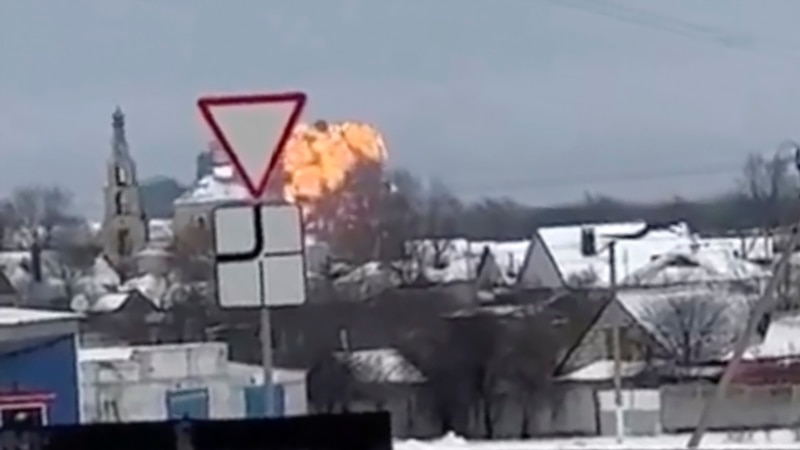Russia Seizes on Il-76 Downing to Stage Massive Propaganda Attack on Ukraine
A firestorm of speculation has followed the downing Wednesday of the Russian Il-76 military plane over Belgorod region, which borders Ukraine.
Russia’s Ministry of Defense claimed that 74 people, including 65 Ukrainian prisoners of war intended for a prisoner swap, were on board. There are no survivors.
Ukrainian sources alleged the plane was carrying S-300 missiles that Russia was transporting to strike Ukraine’s second largest city, Kharkiv, which is roughly 46 miles from Belgorod.
Moscow accused Ukraine of intentionally sacrificing its own POWs, shooting down the plane to pin it on Russia, and then contended Kyiv used Western arms to do so.
“Kiev was well aware of the planned exchange. It also knew how the POWs were to be moved and by what route. The attack against the plane was a deliberate act. This terrorist act clearly demonstrates the Kiev regime’s inability to negotiate,” Russia’s Ministry of Foreign Affairs said.
“This action shows once again the criminal nature of the neo-Nazi dictatorship in Kiev. Its leaders are indifferent to human life. They treat people as “expendable material” and kill them on orders from their Western bosses with Western-supplied arms.”
That fits into longstanding Russian disinformation efforts to paint the Ukrainian government as a terrorist, “neo-Nazi” regime that has no regard for “the lives of its citizens,” while undermining Western aid to help Ukraine defend itself against Russian aggression.
In a video message, Ukrainian President Volodymyr Zelenskyy accused Russia of “playing with the lives of Ukrainian prisoners of war, the feelings of their relatives, and the emotions of our society.”
“All facts must be established. As much as possible, given that the aircraft crashed in Russian territory that is beyond our control.”
Zelenskyy said Ukraine will “insist on an international investigation.”
Russia alleged the plane was not being escorted by fighter jets because of a pre-existing agreement with the Ukrainian side.
Ukrainian intelligence countered this assertion, saying Russia made no effort to warn Ukraine that the airspace over Belgorod needed to be secured for the prisoner exchange – a routine procedure followed by both sides in the past.
Ukraine’s military intelligence service, or GUR, said it “currently does not have reliable and comprehensive information about who exactly was on board the downed IL-76.” The agency said Moscow was responsible for ensuring the safety of the Ukrainian POWs during prisoner swaps.
That comment, The New York Times reported, “hinted at what could have been a tragic mistake” by Ukrainian forces.
Likewise, the English-language Kyiv Independent quoted Ukraine’s military intelligence as saying Russia “did not notify Ukraine about the necessity to ensure the safety of the airspace around Belgorod,” which has been done “repeatedly” in the past. The agency alleged that Russia may have deliberately withheld the warning to “create a threat to the life and safety of the prisoners.”
The New York Times also cited a statement issued by the Ukrainian military’s general staff headquarters noting recent Russian missile strikes on Kharkiv and maintaining that Ukraine’s armed forces will “continue to take measures to destroy delivery vehicles and control the airspace to eliminate the terrorist threat.”
“The general staff statement did not deny shooting down the transport plane,” The New York Times wrote. “Instead, it emphasized how essential it was for Ukraine to strike in Russian territory.”
Andriy Yusov from Ukraine’s military intelligence service told VOA-sister organization Radio Free Europe/Radio Liberty’s Ukrainian service that a prisoner exchange had been scheduled for January 24.
“I can state that the exchange planned for today is currently not taking place,” Yusov said, adding that Ukraine was investigating Russia’s claim the Il-76 was transporting Ukrainian POWs.
The editor and chief of Russian state broadcaster RT Margarita Simonyan posted a list of Ukrainian POWs allegedly onboard at the time of the crash.
Simonyan’s list includes names of 17 prisoners who were “already exchanged on January 3,” the Ukrainian Independent Information Agency of News said.
That exchange, the largest documented so far, saw 230 Ukrainian and 248 Russian prisoners returned home.
Yet the image shared by Simonyan was not a copy of an official document and does not necessarily reflect the identities of the Ukrainian POWs allegedly intended for exchange that day.
Speculation also abounds regarding the flight’s path.
Pro-Ukrainian sources, citing flight tracker data, allege the airlifter was taking off from Belgorod, and headed toward central Russia when it was shot down over Yablonovo, a village just northeast of Belgorod.
Many say the Il-76, which can carry 40 tons, was returning from Iran loaded with weaponry. It has not been verified whether the registration number of that plane, RA-78830, matches the registration number of the plane that was shot down on January 24.
Russia’s Defense Ministry says the aircraft was en route from Chkalovsky, a military air base in the Moscow region, to Belgorod airfield at the time of the incident.
The MOD argues the exchange was to have taken place at the Kolotilovka checkpoint on the Russian–Ukrainian border.
Russia claimed it detected the launch of two missiles from a Ukrainian air defense system in the Kharkiv region.
Russian State Duma (lower house) speaker Vyacheslav Volodin said Ukraine had shot the plane down “with American and German missiles.”
Andrey Kartapolov, the head of the Duma’s defense committee, suggested the plane had been downed with a U.S. Patriot anti-aircraft missile system or a German IRIS-T air defense system.
Kartapolov used the incident to push for official redesignation of “Ukraine as a terrorist state and its ruling regime as a terrorist cell.”
Leonid Slutsky, chairman of the State Duma’s international affairs committee, likewise supported designating Ukraine’s government as a terrorist state.
Russia has long attempted to frame Ukraine’s resistance to Russian aggression as terrorism, particularly regarding the strikes on Russian soil. The United States, United Kingdom, Ukraine and others contend it is legal under international law for Ukraine to hit military targets within Russia.
The circumstances surrounding the downing of the Il-76 military plane, and who or what was on board, remain unknown with independent verification efforts hampered by Russia’s control over the crash scene.
In addition, Russia does have a track record of lying about events surrounding its invasion of Ukraine, including actions by Russian forces characterized as constituting war crimes.
That includes the downing of civilian airliners.
Infamously, Russia introduced an assortment of false, often contradictory narratives, and attempted to thwart the investigation into the downing of Malaysian Airlines flight MH17 over eastern Ukraine, killing all 298 people aboard, on July 17, 2014.
While international investigators found that MH17 was shot down with a Buk-TELAR missile system that was delivered to Ukraine from Kursk, Russia, by the Russian Army’s 53rd Anti-Aircraft Missile Brigade, Russia continues to deny involvement.
At home, Russian President Vladimir Putin also suggested that Yevgeny Prigozhin, funder of the paramilitary Wagner Group and its key members, who staged an aborted rebellion against the Kremlin on June 23, 2023, blew themselves up with hand grenades while flying over Russia’s Tver region two months later, thus committing a mass suicide. U.S. officials earlier said a bomb had likely been placed on the plane.
Russia decided not to investigate that crash under international rules.
Earlier this month, Ukraine dealt a strong blow to Russia’s Air Force, when it shot down an A-50 AWACS plane, and damaged an IL-22 airborne command post, over the Sea of Azov, near Russia-occupied Crimea.
Pro-Russian commentators with links to Russia’s Defense Ministry tried to spin it as a “friendly fire” incident.




